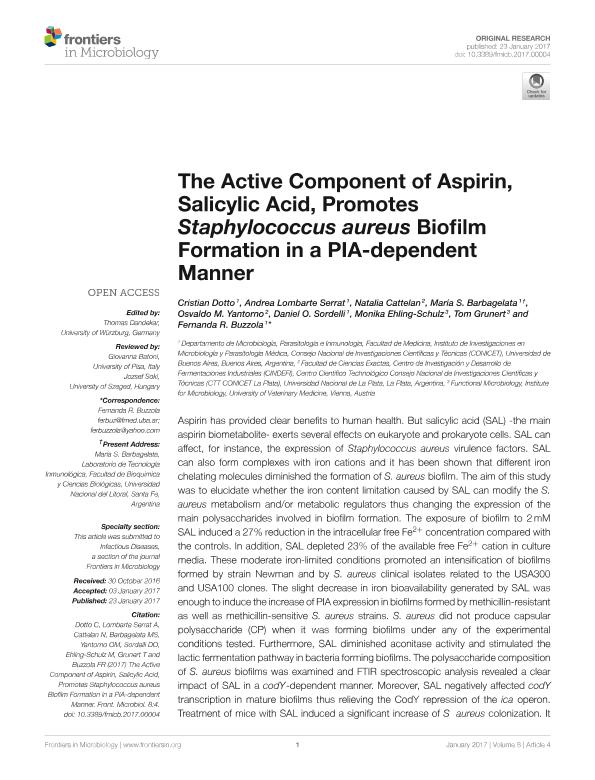Artículo
The active component of aspirin, salicylic acid, promotes staphylococcus aureus biofilm formation in a pia-dependent manner
Dotto, Cristian Marcelo ; Lombarte Serrat, Andrea
; Lombarte Serrat, Andrea ; Cattelan, Natalia
; Cattelan, Natalia ; Barbagelata, María Sol
; Barbagelata, María Sol ; Yantorno, Osvaldo Miguel
; Yantorno, Osvaldo Miguel ; Sordelli, Daniel Oscar
; Sordelli, Daniel Oscar ; Ehling Schulz, Monika; Grunert, Tom; Buzzola, Fernanda Roxana
; Ehling Schulz, Monika; Grunert, Tom; Buzzola, Fernanda Roxana
 ; Lombarte Serrat, Andrea
; Lombarte Serrat, Andrea ; Cattelan, Natalia
; Cattelan, Natalia ; Barbagelata, María Sol
; Barbagelata, María Sol ; Yantorno, Osvaldo Miguel
; Yantorno, Osvaldo Miguel ; Sordelli, Daniel Oscar
; Sordelli, Daniel Oscar ; Ehling Schulz, Monika; Grunert, Tom; Buzzola, Fernanda Roxana
; Ehling Schulz, Monika; Grunert, Tom; Buzzola, Fernanda Roxana
Fecha de publicación:
01/2017
Editorial:
Frontiers Media
Revista:
Frontiers in Microbiology
ISSN:
1664-302X
e-ISSN:
1387-3326
Idioma:
Inglés
Tipo de recurso:
Artículo publicado
Clasificación temática:
Resumen
Aspirin has provided clear benefits to human health. But salicylic acid (SAL) -the main aspirin biometabolite- exerts several effects on eukaryote and prokaryote cells. SAL can affect, for instance, the expression of Staphylococcus aureus virulence factors. SAL can also form complexes with iron cations and it has been shown that different iron chelating molecules diminished the formation of S. aureus biofilm. The aim of this study was to elucidate whether the iron content limitation caused by SAL can modify the S. aureus metabolism and/or metabolic regulators thus changing the expression of the main polysaccharides involved in biofilm formation. The exposure of biofilm to 2 mM SAL induced a 27% reduction in the intracellular free Fe2+ concentration compared with the controls. In addition, SAL depleted 23% of the available free Fe2+ cation in culture media. These moderate iron-limited conditions promoted an intensification of biofilms formed by strain Newman and by S. aureus clinical isolates related to the USA300 and USA100 clones. The slight decrease in iron bioavailability generated by SAL was enough to induce the increase of PIA expression in biofilms formed by methicillin-resistant as well as methicillin-sensitive S. aureus strains. S. aureus did not produce capsular polysaccharide (CP) when it was forming biofilms under any of the experimental conditions tested. Furthermore, SAL diminished aconitase activity and stimulated the lactic fermentation pathway in bacteria forming biofilms. The polysaccharide composition of S. aureus biofilms was examined and FTIR spectroscopic analysis revealed a clear impact of SAL in a codY-dependent manner. Moreover, SAL negatively affected codY transcription in mature biofilms thus relieving the CodY repression of the ica operon. Treatment of mice with SAL induced a significant increase of S aureus colonization. It is suggested that the elevated PIA expression induced by SAL might be responsible for the high nasal colonization observed in mice. SAL-induced biofilms may contribute to S. aureus infection persistence in vegetarian individuals as well as in patients that frequently consume aspirin.
Palabras clave:
Biofilm
,
Cody
,
Iron
,
Mrsa
,
Pia
,
Salicylic Acid
,
Staphylococcus Aureus
Archivos asociados
Licencia
Identificadores
Colecciones
Articulos(CINDEFI)
Articulos de CENT.DE INV EN FERMENTACIONES INDUSTRIALES (I)
Articulos de CENT.DE INV EN FERMENTACIONES INDUSTRIALES (I)
Articulos(IMPAM)
Articulos de INSTITUTO DE INVESTIGACIONES EN MICROBIOLOGIA Y PARASITOLOGIA MEDICA
Articulos de INSTITUTO DE INVESTIGACIONES EN MICROBIOLOGIA Y PARASITOLOGIA MEDICA
Citación
Dotto, Cristian Marcelo; Lombarte Serrat, Andrea; Cattelan, Natalia; Barbagelata, María Sol; Yantorno, Osvaldo Miguel; et al.; The active component of aspirin, salicylic acid, promotes staphylococcus aureus biofilm formation in a pia-dependent manner; Frontiers Media; Frontiers in Microbiology; 8; JAN; 1-2017; 1-18
Compartir
Altmétricas



